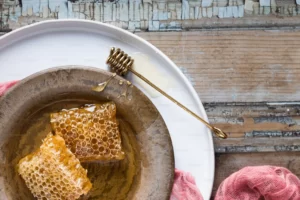Table of Contents
Manuka honey, made exclusively by bees harvesting nectar from New Zealand’s indigenous Manuka flower, is renowned for its healing properties. It is considered the most researched therapeutic honey in the world. Since its therapeutic properties were discovered in 1981, regulatory testing and labeling of Manuka honey have continuously evolved to ensure its authenticity and antibacterial efficacy.
Is it Manuka Honey?
To qualify for export, honey undergoes MPI Manuka Classification, where it is categorized as non-Manuka, multi-floral Manuka, or mono-floral Manuka honey based on attribute tests. These tests include the concentration of four unique Manuka compounds and a Manuka DNA marker. A honey sample, typically representing a 300kg drum of honey or all honey harvested from a single apiary, is tested.
How Pure and Potent is the Manuka Honey?
Once the MPI Manuka classification is determined, multi- and mono-floral Manuka honeys are tested for the potency of manuka-derived antibacterial compounds. While all types of honey have some antibacterial activity due to their hydrogen peroxide content, only active Manuka honey provides additional antibacterial Non-Peroxide Activity (NPA). However, not all Manuka honey carries this additional antibacterial activity.
To determine the potency of NPA, several compounds are tested:
-
Methylglyoxyl (MG): MG is a rare healing compound found at high levels in Manuka honey. The concentration of MG varies depending on the amount of DHA present in the manuka nectar and pollen that bees forage. The higher the concentration of MG, the stronger the healing properties. Active Manuka honey is rated based on the MG concentration present at the time of testing. MG concentration may increase over time, so honey may be tested again prior to sale or packaging to capitalize on the increased value gained from increased MG concentration.
-
Dihydroxy Acetone (DHA): DHA content in active Manuka honey increases over time when stored at appropriate room temperatures as it converts to MGO. Therefore, DHA content at the time of testing can be used to calculate the forecasted potency over time.
-
NPA (Non-Peroxide Activity): NPA is a direct measure of antibacterial potency and is reported as antibacterial performance compared to a phenol equivalent solution. NPA grading measures the distance over which Manuka honey or phenol kills bacteria on a cultured petri dish. A larger distance of bactericide activity indicates a honey with higher NPA. There is a direct correlation between MGO concentration and Non-Peroxide Activity.
-
Hydroxymethylfurfural (HMF): HMF is a breakdown product of fructose, one of the main sugars in honey. HMF increases slowly over time and rapidly when heated. Freshly harvested raw honey usually contains less than 10 mg/kg HMF, while international food standards require HMF to be less than 40 mg/kg. Honey exposed to excessive temperature during extraction or blending may have a reduction in quality.
To qualify for export as active Manuka honey, a rigorously tested sample must include the appropriate concentrations of the above compounds to ensure authenticity, purity, and antibacterial efficacy.
UMF™ or MG/MGO™ Rating?
Export honey labels must display the MPI classification, but the antibacterial activity can be reported using either of two trusted grading systems.
-
Methylglyoxyl concentration (MG mg/kg or MGO™ mg/kg): MG grading is applicable to both multi- and mono-floral Manuka honey. The testing regime for MG or MGO is described above, and there is a direct correlation between MG concentration and Non-Peroxide Activity.
-
UMF™ (Unique Manuka Factor): Active mono-floral Manuka honey may be UMF rated. The UMF grading system was developed and is licensed by The UMF Honey Association. Honey manufacturers that meet UMF standards may label honey with the UMF trademark and appropriate ranking. The UMF grading system measures not only MG, DHA, HMF, and NPA but also Leptosperin, a unique Manuka-specific chemical marker, providing an additional measure of Manuka honey authenticity.
In conclusion, Manuka honey undergoes rigorous testing to ensure its authenticity, purity, and antibacterial efficacy. Various compounds are tested to determine its potency, and different grading systems are used to report its antibacterial activity. This ensures that consumers can trust the quality and benefits of Manuka honey. Manuka Honey testing is essential to maintain the integrity of this renowned therapeutic honey.



